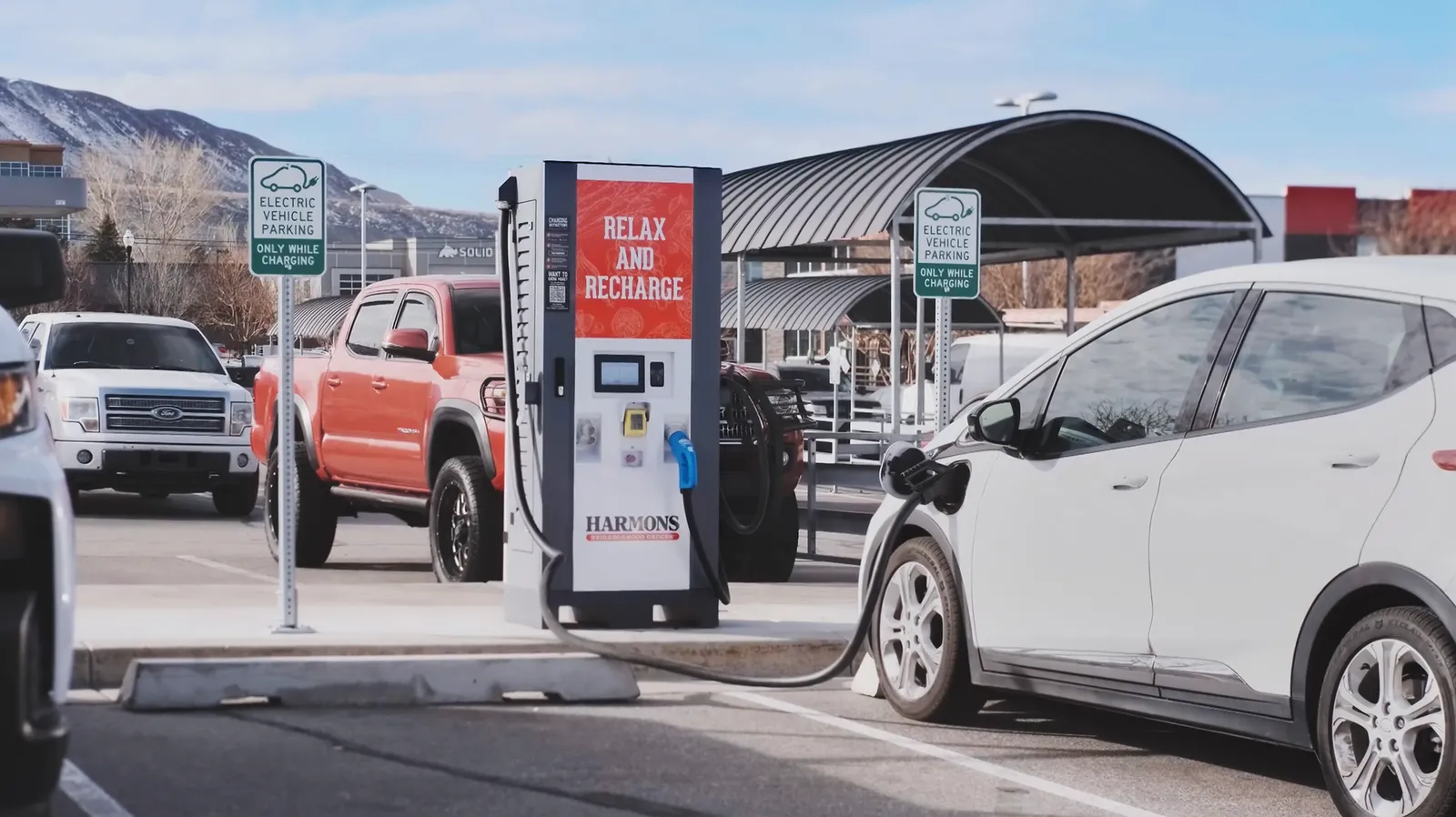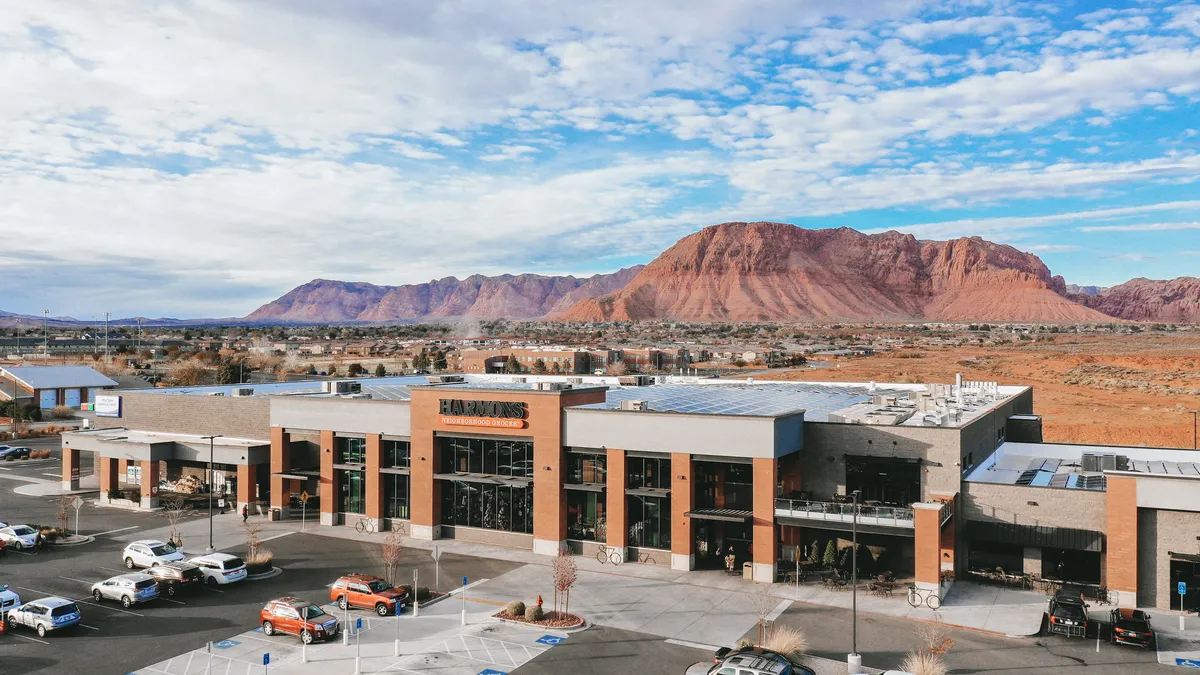This story is the third in a three-part series on how sustainability ties into grocers' bottom lines.
Harmons Neighborhood Grocer, a family-owned and locally run Utah grocery chain, moved sustainability to the forefront of its mission when it brought on its first-ever director of sustainability, Kate Whitbeck, back in 2020.
Prior to Whitbeck’s hiring, the grocer never had a role dedicated to managing greener efforts that went beyond food waste, Whitbeck said in an interview. In her new position, Whitbeck focuses on the implementation, execution and measurements of sustainability initiatives, like the nearly completed rollout of LED lighting and the addition of cardboard balers at stores.
Harmons currently operates 20 supermarkets and a flower shop, with some locations also offering services like pickup and delivery, a pharmacy, a fuel stop, electric vehicle charging stations, a cooking school and even a post office. Since Whitbeck’s arrival, the grocer has stepped up its efforts to integrate sustainability into its overall operations.
"I don't think we had particularly concrete objectives around sustainability. Before that I think the focus was primarily on waste," Whitbeck said about Harmons before she was hired. "It's sort of broadened and deepened just because they now have one person whose sole focus is on sustainability."
In a recent interview with Grocery Dive, Whitbeck shared how she advances Harmons sustainable practices and balances those projects with consideration for the company’s bottom line.
This interview has been edited for length and clarity.
GROCERY DIVE: How does road mapping for sustainability initiatives play out at Harmons? How do you make sure these goals line up with the company’s budgeting plan?
KATE WHITBECK: Harmons has had a number of carbon footprint analyses performed over the years. Before my time, they outsourced these analyses and that was one of the first things I embarked on. I conducted a carbon footprint analysis in 2021 that gave us some baseline data that we can measure progress on going forward. And it also just sort of helps us establish objectives in each of the areas where we are evaluating various metrics.
We don’t have a sustainability budget, per se. I think it’s sort of on a project-by-project basis. We look at the top priorities and what’s going to work within the budget this year, and it’s just a negotiating process with the board, essentially.
How do you prioritize planning and implementing new sustainable strategies?
I’m trying to let that carbon footprint analysis be the guide. If it were up to me, we really would take sort of an emissions focus in terms of goals and objectives and focus entirely on “where can we make the greatest impact?” and “which changes do we need to focus on to make the greatest impact?”
But the challenges are [that] some of these changes require significant capital investment, so I can’t do everything I want to do all at once. But we have to pace ourselves and figure out “what are the priorities in each of the different areas?” and “what’s going to make sense this year?” and then what the focus is next year.
What role does finance play in Harmons’ sustainability efforts? How do you bring sustainability efforts into financial planning?
I understand some individuals are obviously swayed by a financial argument more so than an environmental argument. So I try to spell out if there’s an ROI on a particular investment. Obviously, not everything we do related to sustainability can show a cost savings but, fortunately, with most interventions related to energy or waste, there are cost savings to be had. So those are obviously easier sells than some of the other interventions.

How long do sustainability practices typically take to start generating a profit for the company?
I don’t think there’s a typical number, it’s very specific to the initiative and to the location. I think it’s obviously anything that’s five years and under, it’s going to be an easier sell. There are some things that I think are our long-term investments that are definitely worthwhile, but those tend to be a harder sell, certainly.
Historically, we were diverting cardboard in compactors, and in most of our stores we are shifting over to doing that in a cardboard baler and so that’s usually about five years or less in terms of an ROI. But again, it depends on how far that store is from the cardboard recycling destination and how much cardboard they generate, so those are the two factors that impact whether that’s a longer or shorter ROI.
We only have solar panels on one store and that has a much longer ROI. So those types of initiatives that require a considerable capital investment, and then ongoing maintenance and repair, and then the factors related to changing electricity rates are a harder sell just because there are so many unknowns in the future that you can’t always calculate in advance.
The jury is still out on the solar panel’s ROI.
Besides the carbon footprint calculator, how do you measure the performance of Harmons’ sustainability efforts?
I kind of divide them into metrics that the store has some control over, and then to those that are more influenced by sort of the equipment and the systems in the store and the age of the store.
All of our stores are evaluated according to seven different metrics on a monthly basis. And so our stores tend to be fairly competitive, and so these are things their associates are engaged in.
So we’re looking at waste diversion. What percentage of the waste are they diverting from the landfill at each store? We’re looking at tonnage rates. How full are their compactors when they’re being hauled? That’s a measure of, if your compactor is half full, there’s a greater emissions footprint per ton of waste and you’re spending a larger amount per ton of waste to dispose of it.
We’re also considering reusable bag sales. Are stores giving bag credit for every bag that comes through checkouts? They conduct different audits each month to make sure that they don’t have contamination they’re recycling in their green waste. They have a training score. Are all their associates up to date on their sustainability-related trainings? And then how much paper are they using in their store on a monthly basis?
Each store is also supposed to hold a Sustainability Committee meeting, so that the management team meets and discusses their metrics, discusses successes and goals and objectives going forward. Any sort of lessons learned that they could share with other stores and then send those notes to me.
These are things that, in the grand scheme of things, in terms of emissions, probably don’t have the largest impact, but they’re ways to engage associates in these topics and educate associates around sustainability issues that are impacting stores.

What would you say are some of Harmons greatest sustainability achievements so far? What were some of its biggest challenges to overcome?
I feel like we’ve been doing a great job on waste. I think we’ve seen a steady increase in our diversion rate over the last three years and we’re nearing that 60% mark of waste by weight diverted from the landfill, which I’m really proud of our stores for all of the effort that they’ve invested in that number.
We’ve made a lot of progress when it comes to lighting. We’re almost done with lighting in terms of converting all of our stores to LED lighting. We’re pushing towards putting doors on our refrigerated cases, which reduces energy use by about 60%. And then in terms of refrigeration gases and shifting over those lower GWP (global warming potential) gases is also something I’m proud of.
In terms of going forward, packaging is something we’re just starting. We’ve got some great more sustainable options, but I’d really like to make sure that everything that’s going out of our stores and that we’re packaging ourselves in-stores is more sustainable.
Renewable energy is another area. Over time, I’d like to shift this over to renewable energy at all of our stores. We’re expanding our electric vehicle charges. At this point, I think we have four locations that have EV chargers, but eventually, I’d like to have chargers at every station. There are a number of different initiatives I’d like to expand.













